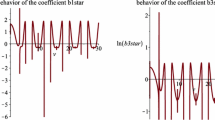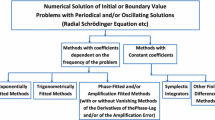Abstract
The combination of predictor–corrector (PEC) pairs of Adams methods can be generalized to high derivative methods using Obreshkov quadrature formulae. It is convenient to construct predictor–corrector pairs using a combination of explicit (Adams–Bashforth for traditional PEC methods) and implicit (Adams–Moulton for traditional PEC methods) forms of the methods. This paper will focus on one special case of a fourth order method consisting of a two-step predictor followed by a one-step corrector, each using second derivative formulae. There is always a choice in predictor–corrector pairs of the so-called mode of the method and we will consider both PEC and PECE modes. The Nordsieck representation of Adams methods, as developed by C. W. Gear and others, adapts well to the multiderivative situation and will be used to make variable stepsize convenient. In the first part of the paper we explain the basic approximations used in the predictor–corrector formula. Those can be written in terms of Obreshkov quadrature. Next section we discuss the equations in terms of Nordsieck vectors. This provides an opportunity to extend the Gear Nordsieck factorization to achieve a variable stepsize formulation. Numerical tests with the new method are also discussed. The paper will present Prothero–Robinson and Kepler problem to illustrate the power of the approach.









Similar content being viewed by others
References
Nordsieck A (1962) On numerical integration of ordinary differential equations. Math Comput 16(77):22–49
Obreshkov N (1981) Sochineniya. Tom 2, Bŭlgar. Akad. Nauk, Sofia
Hairer E, Nørsett SP, Wanner G (1993) Solving ordinary differential equations I. Nonstiff problems. Springer, Heidelberg
Butcher JC (2008) Numerical methods for ordinary differential equations. Wiley, Chichester
Gear WC (1971) Numerical initial value problems in ordinary differential equations. Prentice-Hall Inc., Englewood Cliffs
Bashforth F, Adams JC (1883) An Attempt to test the Theories of Capillary Action by comparing the theoretical and measured forms of drops of fluid. In: Adams JC (ed) With an explanation of the method of integration employed in constructing the tables which give the theoretical forms of such drops. University Press, Cambridge
Hull TE, Enright WH, Fellen BM, Sedgwick AE (1972) Comparing numerical methods for ordinary differential equations. SIAM J Numer Anal 9(4):603–637
Milne WE (1949) Numerical calculus. Princeton University Press, London
Acknowledgments
The second author acknowledges partial support from the Brno University of Technology, project no. FSI-S-11-3.
Author information
Authors and Affiliations
Corresponding author
Rights and permissions
About this article
Cite this article
Butcher, J.C., Sehnalová, P. Predictor–corrector Obreshkov pairs. Computing 95, 355–371 (2013). https://doi.org/10.1007/s00607-012-0258-0
Received:
Accepted:
Published:
Issue Date:
DOI: https://doi.org/10.1007/s00607-012-0258-0




